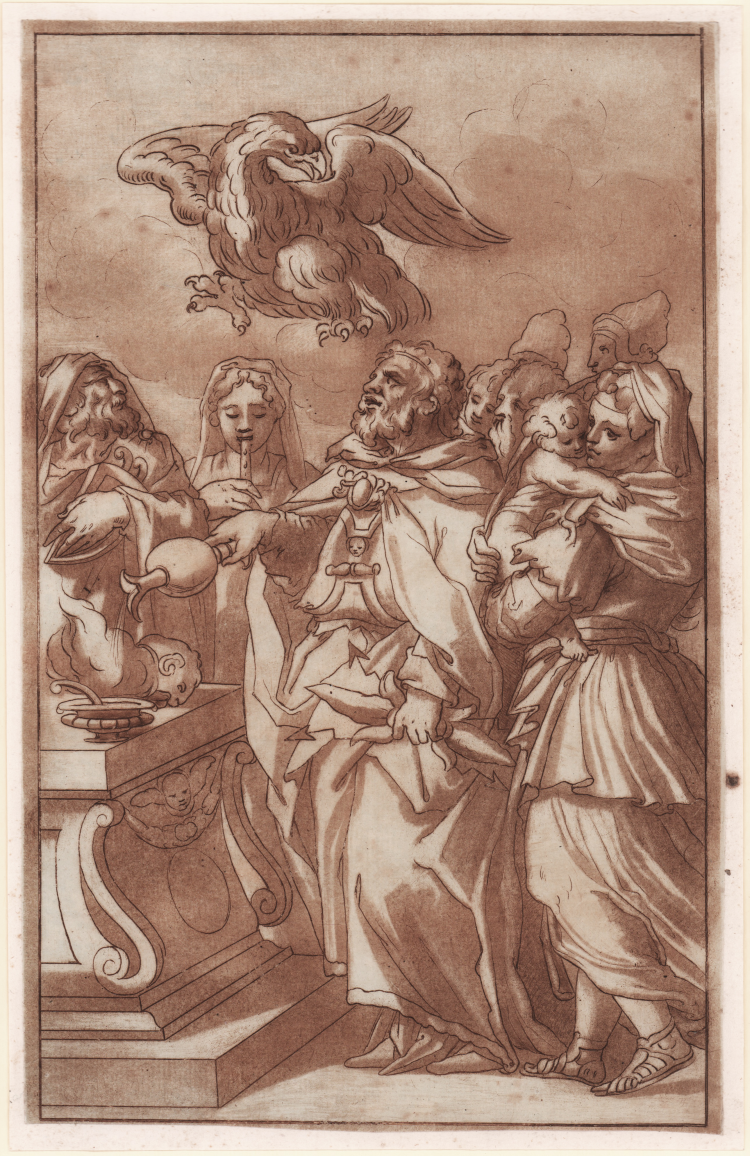



| Reference: | s22356 |
| Author | Stefano MULINARI |
| Year: | 1774 ca. |
| Measures: | 204 x 324 mm |


| Reference: | s22356 |
| Author | Stefano MULINARI |
| Year: | 1774 ca. |
| Measures: | 204 x 324 mm |
Etching and aquatint engraving, contained in the magnificent collection entitled “Disegni originali di eccellenti pittori esistenti nella R. Galleria di Firenze incisi e imitati nelle loro grandezze e colori” published at various times and with partially different titles between 1774 and 1785.
Beautiful example, printed in brown ink on contemporary laid paper, trimmed at the marginal line, in excellent condition.
Painter and engraver, a pupil of Andrea Scacciati, Mulinari is among the greatest reproduction engravers of the second half of the 18th century. In collaboration with Scacciati he engraved between 1766 and 1774 the hundred prints of the original Disegni originali d'eccellenti Pittori esistenti nella R. Galleria di Firenze. In 1775 he published Istoria pratica dell'incominciamento e progressi della pittura; to 1780 dates the important Saggio delle cinque scuole di pittura italiana with reproductions of drawings and paintings by great Italian artists such as Raphael, Annibale Carracci, Guercino, and Ribera. His last work is the Raccolta di venti disegni originali d'eccellenti pittori, published in Florence in 1782. The technique adopted by Mulinari in translating the drawings into print is distinguished by the use, along with etching, of lavis, which allows for pictorial effects similar to those of watercolor.
This work was preceded in 1766 by a volume reproducing 100 drawings in the same collection, in which forty-one drawings were copied by Andrea Scacciati (1725–1771), and the rest by Mulinari. Mulinari continued after Scacciati’s death with the present work and in 1778 he published Istoria practica dell’incominciamento e progressi della pittura (50 plates).
All three volumes display mastery of a tonal printmaking process – related, but distinct from aquatint – which Scacciati and Mulinari had learned in Florence from the Nuremberg engraver Johann Adam Schweickart. The technique involved a controlled brushing of the plate with an acidic paste, producing irregular patterns similar to those produced by etching through an aquatint ground. The plates were then coloured a la poupée: a different-coloured ink was daubed on each drawing, before a single pull of the plate.
The work was sold by subscription, without a publisher or bookseller as middlemen, to decrease the financial risk involved, and increase Mulinari’s financial reward.
Bibliografia
LeBlanc “Manuel de l’Amateur d’Estampes” Parigi 1856 vol. 2 pag. 62.
Stefano MULINARI (Firenze circa 1741 - 1790)
|
Pupil of Andrea Scacciati, and collaborator on plates in 'Disegni originali d'eccellenti pittori esistenti nella R.Galleria di Firenze', published in 1766. He continued after Scacciati's death in 1771 with a second volume with the same title, with titlepage dated 1774 (this contains 171 plates, mostly printed more than one to a sheet).
Also responsible for 'Istoria practica dell'incominciamento e progressi della pittura' of 1778 (50 plates).
|
Stefano MULINARI (Firenze circa 1741 - 1790)
|
Pupil of Andrea Scacciati, and collaborator on plates in 'Disegni originali d'eccellenti pittori esistenti nella R.Galleria di Firenze', published in 1766. He continued after Scacciati's death in 1771 with a second volume with the same title, with titlepage dated 1774 (this contains 171 plates, mostly printed more than one to a sheet).
Also responsible for 'Istoria practica dell'incominciamento e progressi della pittura' of 1778 (50 plates).
|